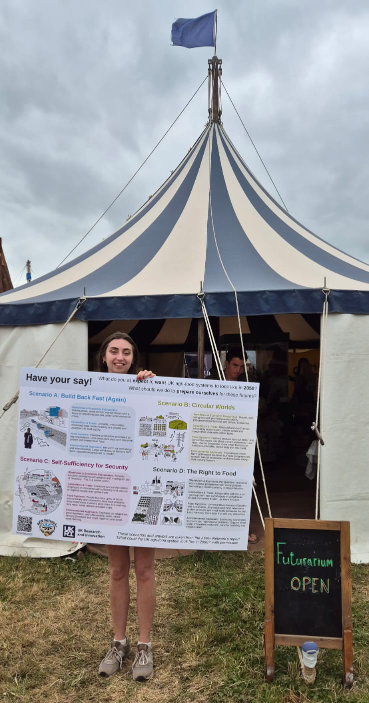AFN Network+ scenarios live at Glastonbury
The AFN Network+ scenarios made it to the Glastonbury Festival , as part of the UKRI research project, TRAnsforming the DEbate about livestock systems (TRADE). Their stand at Glastonbury extended its focus to encompass broader aspects of food sustainability under the banner of ‘Feeding the Future.’ Visitors delved into various dimensions of food systems and sustainability, such as land use, environmental impact, human health, consumption patterns, and more.
This included a ‘four futures’ voting station, which used the four AFN scenarios to stimulate discussion and encourage reflection on our diverse possible futures. Visitors engaged deeply with the scenarios, and used sticky notes for voting and feedback. It was fascinating to see the range of perspectives expressed.
Below is a summary of the feedback received for each scenario:
- Scenario A: Build Back Fast (Again) – most common for ‘expect to see’
Many participants expressed concern that this scenario, with its focus on rapid recovery and short-term gains, might be the most likely outcome. There was a notable pessimism about our ability to move beyond this approach, with fears that economic pressures would prioritise quick fixes over long-term sustainability. - Scenario B: Circular Worlds – most common for ‘like to see’
This scenario was the most positively received. People were excited about the idea of circular farming systems and sustainable practices. They were particularly enthusiastic about the concept of reducing waste, promoting social equity, and supporting local food systems. However, there was also a concern that transitioning to such a model might be hindered by current economic and political structures. - Scenario C: Self-Sufficiency for Security – second most common for ‘expect to see’
Participants saw this scenario as a possible worst-case reality, particularly given current geopolitical uncertainties. There was some acceptance of the need for increased self-sufficiency and local food production. However, concerns were raised about the downsides, such as higher food costs and limited variety, which might impact lower-income communities disproportionately. - Scenario D: The Right to Food – second most common for ‘like to see’
This scenario was well received. People appreciated the focus on ensuring that everyone has access to healthy food and supporting diverse, small-scale producers. Despite this, there was some skepticism about whether this idealistic vision could be realistically achieved given existing global trade dynamics and economic pressures.
Overall, while there was a general hope for more progressive scenarios like B and D, there was a clear awareness of the challenges and barriers that might prevent their realisation. The feedback reflected a strong desire for a more sustainable and equitable food system, coupled with an understanding of the complex realities we face.
Huge thanks to Kirsty Blair from the University of Edinburgh, and the rest of the TRADE team, for making this happen.




